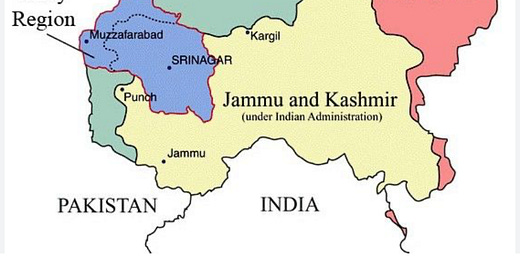Stand Off in South Asia
While we are waiting for The Armed Forces of Pakistan to retaliate, we raise concern about the political instability in Pakistan, that may drive this conflict all the way to a catastrophic conclusion.
Attack
Wednesday morning May 7 we woke up to bulletins reporting that The Armed Forces of India (AFI) had attacked 9 facilities, that Delhi claims are belonging to various named organizations across the line of demarcation from Jammu & Kashmir, a contested region in the India vs. Pakistan conflict.
It is still too early to say, what exactly took place. Tensions have been high, since 26 tourists were killed on the Indian side of Kashmir on April 22, the largest mass killing of Indians by gunmen in years. The Armed Forces of Pakistan (AFP) had moved their F-16s to bases in the far west, while keeping their JF-17s on high alert. In the attack, it is alleged that AFI lost at least 2 fighter jets to PL-15E missiles, possibly fired from Chengdu J-10C fighter planes operated by the Pakistan Air Force (one Rafale and one Mirage 2000 confirmed down). The nine targets on the ground seems to have been hit with surgical accuracy; although clouded by the fog of war, the incidence appears to be clear cut in its message: Delhi is tied of Islamabads apparent lack of control over its territory, and will ultimately hold Pakistan responsible for attacks carried out on Indian soil planned and prepared on the other side of the demarcation line.
Political instability
We are at the root of the problem. Pakistan is on the verge of collapse. In my Polity Volatility Index (PVI), Pakistan is code purple indicating that it is under reconstruction. For decades Pakistan has been code red and served as the quintessential case of political instability in my teaching: While India is safe within code orange, Pakistan has so few functioning political institutions, that it is does not function well. The police force is dysfunctional, subjected, as everything else in Pakistan, to the military. AFP is functioning remarkably well, under the difficult cultural, economic, and social circumstances. The army is the ultimate decider in society. Some years ago AFP managed to get an old cricket captain on top. That broke the spell of the political dynasties usually occupying the marionette like position as leader of government, but since he, the charismatic Imran Khan, developed a will of his own, total chaos has dominated public life in Pakistan. Already in Political Order in Changing Societies from 1968, Huntington heralds Pakistan as being in a ‘praetorian situation;’ experiencing constant turmoil between political elites raising demand for ‘praetor’ (first officer in the military structure) to stabilize the political order.
Porous Pakistan
The reign of Musharraf (2001 - 2008) resembled what we usually understand as an actual government, but usually Islamabad is ruled by a junta behind the scenes. As already mentioned, AFP is responsible for everything in Pakistan, but does not exercise full control, why Pakistan is home to many armed organizations on its soil; many of them in direct confrontation with AFP; others, existing in the outer rims of the range of the Pakistan’s military intelligence (ISI), surviving with support from God knows were, but one could line up the usual suspect for a start. Delhi may point to Islamabad as responsible for the mess, but the information about the formation and activities of these groups have proven to be impenetrable; nobody but the operational agents themselves know how the nodes are connected, and most of them have only local knowledge of the complex networks.
Escalation?
AFP is now seeking an appropriate response to the loss of life endured on their side. If they manage to keep their retaliation measured, then it should be possible to contain the situation from escalating; no parties have an apparent interest in escalation. The major regional power India, may dominate the smaller regional power, Pakistan on various steps up the escalation ladder, but cannot hope to establish dominance as such; Pakistan is a strong military force, and if defeated may find resolve in deploying nuclear weapons. A veritable stand off.
Conclusion
My perspective on the conflict is that Islamabad may be subject to internal dynamics where different actors in the political hierarchy may get into internal struggle for positions, a struggle that could lead to a sudden lash out by AFP, disproportionally directed at AFI. Whether it will happen this time seems unlikely, but the potential rises as Pakistan descends into further internal fragmentation. My point is, that in the case of abrupt escalation, Delhi would have few options but to engage in an overall attack with the aim of establishing control in the air. That would leave the situation unhinged, to speak in the language of John Mearsheimer: China is a natural supporter of Islamabad, while USA may land in Delhis camp. Russia is supporter of Delhi’s; Moscow was mentioned yesterday, as a potential broker, possibly due to Sergei Lavrov, the nestor of diplomacy, whose status could provide the necessary cloud of impartiality. It is still early days in this conflict that can be traced back to 1942. Delhi and Islamabad are technically at war, and have sought to reach an understanding since 1972.





Another brilliant analysis.